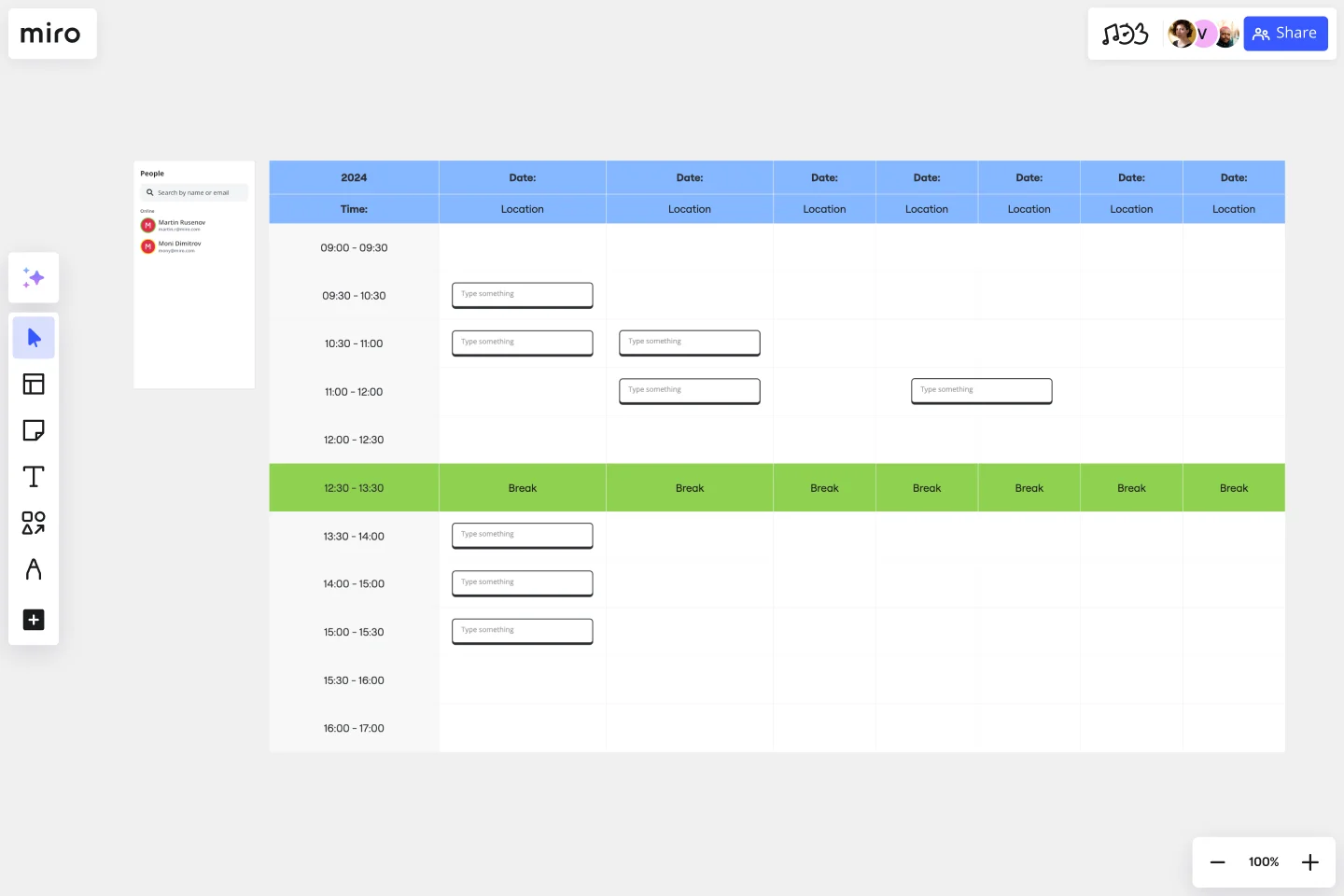Schedule Template
Streamline your time management with the schedule template.
About the Schedule Template
Scheduling is the backbone of many successful projects, events, and daily routines. Whether you're mapping out a conference, planning a project timeline, or simply organizing your week, a visual representation can make all the difference. Enter the schedule template, a universal tool to simplify your time management process.
What's a schedule template?
A schedule template is a pre-formatted visual layout that allows users to plot out time-specific events, tasks, or activities over a set duration. It's akin to a calendar or planner but is often more flexible, allowing for customization based on specific needs or projects.
How to use the schedule template in Miro
Follow these simple steps to use the schedule template effectively:
Edit time slots: Click on any time slot you wish to change. You can adjust the duration or rename it with just a few clicks.
Adjust the overall timeframe: If you need a broader or narrower view, change the timeframe to reflect days, weeks, or even months.
Add specific events: Click on the desired slot and input the event, task, or activity you wish to schedule.
Integrate other documents: Drag and drop any artifact to your board, such as images, links, or any other documentation, when needed.
Color-code and customize: Use different colors to categorize or prioritize various events or tasks for added clarity.
Save and share: Once your schedule is tailored to your needs, save it and share it with your team for seamless collaboration.
Why should you use a schedule template?
Efficiency: A visual layout enables quicker planning and adjustments, saving time in the long run.
Clarity: A well-organized template provides a clear overview of tasks, reducing the risk of overlaps or missed appointments.
Flexibility: Adjust the template to fit various timeframes, whether a week, a month, or a custom duration.
Collaboration: Sharing the schedule allows teams to align, ensuring everyone is on the same page.
Customization: Beyond time management, you can integrate other docs and visual elements to provide context or enhance understanding.
Can I adjust the time intervals on the template?
Absolutely. The template is designed to be adaptable, allowing users to customize the intervals per their needs.
Is it possible to color-code events or tasks?
Yes, color-coding is an option to visually categorize or prioritize different events, making the schedule even more intuitive.
How can I share my schedule with others?
Sharing is easy. Once your schedule is set, you can provide access to anyone, enabling seamless collaboration by sharing your board link.
Are there options for recurring events or tasks?
While the template allows individual event input, users can easily replicate or duplicate events to indicate recurrences.
Get started with this template right now.
Cross Functional Flowchart
Works best for:
Org Charts, Business Management
Have a quick look at everyone on a project and see exactly what they’ll contribute. That’s the clarity and transparency a cross-functional flowchart will give you. These are also called “swim lane” flowcharts because each person (each customer, client, or representative from a specific function) is assigned a lane—a clear line—that will help you visualize their roles at each stage of the project. This template will empower you to streamline processes, reduce inefficiencies, and make meaningful cross-functional relationships.
Project Charter Template
Works best for:
Project Management, Documentation, Strategic Planning
Project managers rely on project charters as a source of truth for the details of a project. Project charters explain the core objectives, scope, team members and more involved in a project. For an organized project management, charters can be useful to align everyone around a shared understanding of the objectives, strategies and deliverables for a project of any scope. This template ensures that you document all aspects of a project so all stakeholders are informed and on the same page. Always know where your project is going, its purpose, and its scope.
RAID Log Template
Works best for:
Agile Methodology, Project Management, Agile Workflows
Use the RAID Log template to better understand potential risks, assumptions, issues, and dependencies relating to an upcoming project. With this information, you can make effective contingency plans and prepare your resources accordingly. You’ll know what could go wrong throughout the project and how to fix the problem.
5W2H Template
Works best for:
Project Management
The 5W2H template is a tool used in project management and analysis to break down information systematically. By addressing the who, what, when, where, why, how, and how aspects of the issue, the template ensures that no critical detail is overlooked. The analysis enhances problem-solving and communication within teams. The structured nature of the template streamlines decision-making maintains focus, and helps achieve project goals.
Company Organization Chart
Works best for:
Org Charts, Operations, Mapping
The Company Organization Chart template enables clear visualization of hierarchical structures within an organization. It helps teams understand reporting lines, roles, and responsibilities, fostering transparency and alignment. With customizable features, such as color-coding and labeling, this template facilitates effective communication and decision-making across departments and levels.
Production Timeline Template
Works best for:
Project Management
The Production Timeline Template is a visual roadmap, systematically outlining the sequence of activities, tasks, and milestones of a project over a defined timeframe. This graphical representation ensures clarity and direction for project teams, allowing everyone to see the project's entirety in one consolidated view. One of its standout benefits is fostering team alignment. By visually laying out tasks and deadlines, team members clearly understand their roles, responsibilities, and timelines, ensuring harmonious collaboration and reducing potential miscommunication or overlaps. This alignment streamlines the workflow and significantly enhances overall project efficiency.
